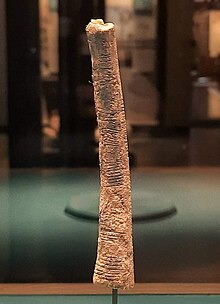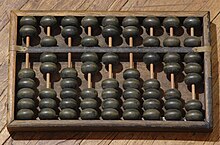User:Phlsph7/Arithmetic history
History[edit]

The earliest forms of arithmetic are sometimes traced back to counting and tally marks used to keep track of quantities. Some historians suggest that the Lebombo bone (dated about 43,000 years ago) and the Ishango bone (dated about 22,000 to 30,000 years ago) are the oldest arithmetic artifacts but this interpretation is disputed.[1][2][3] However, a basic sense of numbers may predate these findings and might even have existed before the development of language.[4][5]

However, it was not until the emergence of ancient civilizations that a more complex and structured approach to arithmetic began to evolve, starting around 3000 BCE. This became necessary because of the increased need to keep track of stored items, manage land ownership, and arrange exchanges.[6][7] All the major ancient civilizations developed non-positional numeral systems to facilitate the representation of numbers. They also included symbols for operations like addition and subtraction and were aware of fractions. Examples are Egyptian hieroglyphics as well as the numeral systems used in Sumeria, China, and India.[8][9] The first positional numeral system was developed by the Babylonians starting around 1800 BCE. This was a significant improvement over earlier numeral systems since it made the representation of large numbers and calculations on them more efficient.[10][11] Abacuses were used as hand-operated calculating tools since ancient times as efficient means for performing complex calculations.[12][13]
Early civilizations primarily used numbers for concrete practical purposes and lacked an abstract concept of number itself.[14][15] This changed with the ancient Greek mathematicians, who began to explore the abstract nature of numbers rather than studying how they are applied to specific problems.[16][15] Another novel feature was their use of proofs to establish mathematical truths and validate theories.[16][17] A further contribution was their distinction of various classes of numbers, such as even numbers, odd numbers, and prime numbers.[18][19] This included the discovery that numbers for certain geometrical lengths are irrational and therefore cannot be expressed as a fraction.[20][21] The works of Thales of Miletus and Pythagoras in the 7th and 6th centuries BCE are often regarded as the inception of Greek mathematics.[22][23] Diophantus was an influential figure in Greek arithmetic in the 3rd century BCE because of his numerous contributions to number theory and his exploration of the application of arithmetic operations to algebraic equations.[24][25]
The ancient Indians were the first to developed the concept of zero as a number to be used in calculations. The exact rules of its operation were written down by Brahmagupta in around 628 CE.[26][27][28] The concept of zero as a general term existed long before but it was understood as an empty placeholder rather than an object of arithmetic operations.[29][30] Brahmagupta further provided a detailed discussion of calculations with negative numbers and their application to problems like credit and debt.[31][27][28] The concept of negative numbers itself is significantly older and was first explored in Chinese mathematics in the first millennium BCE.[32][33]
Indian mathematicians developed the positional decimal numeral system common today. For example, a detailed treatment of its operations was provided by Aryabhata around the turn of the 6th century CE.[34][28] The Indian decimal system was further refined and expanded during the Islamic Golden Age by Arab mathematicians such as Al-Khwarizmi. His work was influential in introducing the decimal numeral system to the Western world, which had previously relied on the non-positional Roman numeral system.[35][28] There, it was popularized by mathematicians like Leonardo Fibonacci, who lived in the 12th and 13th centuries and also developed the Fibonacci sequence.[36][37] During the Middle Ages and Renaissance, many popular textbooks were published to cover the practical calculations for commerce. The use of abacuses also became widespread in this period.[38][39] In the 16th century, the mathematician Gerolamo Cardano conceived the concept of complex numbers as a way to solve cubic equations.[40][41]

The first mechanical calculators were developed in the 17th century and greatly facilitated complex mathematical calculations, such as Blaise Pascal's calculator and Gottfried Wilhelm Leibniz's stepped reckoner.[43][44][45] The 17th century also saw the discovery of the logarithm by John Napier.[46][47]
In the 18th and 19th centuries, mathematicians such as Leonhard Euler and Carl Friedrich Gauss laid the foundations of modern number theory.[48][49][50] Another development in this period concerned work on the formalization and foundations of arithmetic, such as Georg Cantor's set theory and the Dedekind–Peano axioms used as an axiomatization of natural-number arithmetic.[51][52] Computers and electronic calculators were first developed in the 20th century. Their widespread use revolutionized both the accuracy and speed with which even complex arithmetic computations can be calculated.[53][54][55]
- Thiam, Thierno; Rochon, Gilbert (31 August 2019). Sustainability, Emerging Technologies, and Pan-Africanism. Springer Nature. ISBN 978-3-030-22180-5.
- Ponticorvo, Michela; Schmbri, Massimiliano; Miglino, Orazio (9 May 2019). "How to Improve Spatial and Numerical Cognition with a Game-Based and Technology-Enhanced Learning Approach". In Vicente, José Manuel Ferrández; Álvarez-Sánchez, José Ramón; López, Félix de la Paz; Moreo, Javier Toledo; Adeli, Hojjat (eds.). Understanding the Brain Function and Emotions: 8th International Work-Conference on the Interplay Between Natural and Artificial Computation, IWINAC 2019, Almería, Spain, June 3–7, 2019, Proceedings, Part I. Springer. ISBN 978-3-030-19591-5.
- Ang, Tian Se; Lam, Lay Yong (6 April 2004). Fleeting Footsteps: Tracing The Conception Of Arithmetic And Algebra In Ancient China (Revised Edition). World Scientific. ISBN 978-981-4483-60-5.
- Yadin, Aharon (19 August 2016). Computer Systems Architecture. CRC Press. ISBN 978-1-315-35592-4.
- Brown, David (26 April 2010). "The measurement of time and distance in the heavens above Mesopotamia, with brief reference made to other ancient astral science". In Morley, Iain; Renfrew, Colin (eds.). The Archaeology of Measurement: Comprehending Heaven, Earth and Time in Ancient Societies. Cambridge University Press. ISBN 978-0-521-11990-0.
- Madden, Daniel J.; Aubrey, Jason A. (12 September 2017). An Introduction to Proof through Real Analysis. John Wiley & Sons. ISBN 978-1-119-31472-1.
- Payne, Andrew (2017). The Teleology of Action in Plato's Republic. Oxford University Press. ISBN 978-0-19-879902-3.
- Bloch, Ethan D. (14 May 2011). The Real Numbers and Real Analysis. Springer Science & Business Media. ISBN 978-0-387-72177-4.
- Lützen, Jesper (2023). A History of Mathematical Impossibility. Oxford University Press. ISBN 978-0-19-286739-1.
- Klein, Jacob (22 April 2013). Greek Mathematical Thought and the Origin of Algebra. Courier Corporation. ISBN 978-0-486-31981-0.
- Bradley, Michael J. (2006). The Birth of Mathematics: Ancient Times To 1300. Infobase Publishing. ISBN 978-0-7910-9723-6.
- Cai, Tianxin (25 July 2023). A Brief History of Mathematics: A Promenade through the Civilizations of Our World. Springer Nature. ISBN 978-3-031-26841-0.
- Conradie, Willem; Goranko, Valentin (28 April 2015). Logic and Discrete Mathematics: A Concise Introduction. John Wiley & Sons. ISBN 978-1-118-76109-0.
- Oakes, Elizabeth (1 July 2020). Encyclopedia of World Scientists, Updated Edition. Infobase Publishing. ISBN 978-1-4381-9545-2.
- Wedell, Moritz (31 August 2015). "Numbers". In Classen, Albrecht (ed.). Handbook of Medieval Culture. Volume 2. Walter de Gruyter GmbH & Co KG. ISBN 978-3-11-037763-7.
- Koetsier, Teun (20 November 2018). The Ascent of GIM, the Global Intelligent Machine: A History of Production and Information Machines. Springer. ISBN 978-3-319-96547-5.
- Cignoni, Gioanni A.; Cossu, Giovanni A. (30 November 2016). "The Global Virtual Museum of Information Science & Technology, a Project Idea". In Tatnall, Arthur; Leslie, Christopher (eds.). International Communities of Invention and Innovation: IFIP WG 9.7 International Conference on the History of Computing, HC 2016, Brooklyn, NY, USA, May 25-29, 2016, Revised Selected Papers. Springer. ISBN 978-3-319-49463-0.
- Eriksson, Kenneth; Estep, Donald; Johnson, Claes (9 March 2013). Applied Mathematics: Body and Soul: Volume 2: Integrals and Geometry in IRn. Springer Science & Business Media. ISBN 978-3-662-05798-8.
- Weil, André (21 May 2009). Number Theory: An approach through history From Hammurapi to Legendre. Springer Science & Business Media. ISBN 978-0-8176-4571-7.
- Karlsson, Anders (20 December 2011). "Applications of heat kernels on abelian groups". In Goldfeld, Dorian; Jorgenson, Jay; Jones, Peter; Ramakrishnan, Dinakar; Ribet, Kenneth; Tate, John (eds.). Number Theory, Analysis and Geometry: In Memory of Serge Lang. Springer Science & Business Media. ISBN 978-1-4614-1259-5.
- Wang, Hao (3 February 1997). A Logical Journey: From Gödel to Philosophy. MIT Press. ISBN 978-0-262-26125-8.
- Curley, Robert (1 November 2011). Computing: From the Abacus to the iPad. Britannica Educational Publishing. ISBN 978-1-61530-707-4.
- Igarashi, Yoshihide; Altman, Tom; Funada, Mariko; Kamiyama, Barbara (27 May 2014). Computing: A Historical and Technical Perspective. CRC Press. ISBN 978-1-4822-2741-3.
- Hua, Jueming; Feng, Lisheng (14 December 2020). Thirty Great Inventions of China: From Millet Agriculture to Artemisinin. Springer Nature. ISBN 978-981-15-6525-0.
- Chemla, Karine; Keller, Agathe; Proust, Christine (1 January 2023). Cultures of Computation and Quantification in the Ancient World: Numbers, Measurements, and Operations in Documents from Mesopotamia, China and South Asia. Springer Nature. ISBN 978-3-030-98361-1.
- Vullo, Vincenzo (14 February 2020). Gears: Volume 3: A Concise History. Springer Nature. ISBN 978-3-030-40164-1.
- ^ Burgin 2022, pp. 2–3.
- ^ Ore 1948, pp. 1, 6, 8, 10.
- ^ Thiam & Rochon 2019, p. 164.
- ^ Burgin 2022, p. 3.
- ^ Ponticorvo, Schmbri & Miglino 2019, p. 33.
- ^ Burgin 2022, pp. 4–6.
- ^ Ang & Lam 2004, p. 170.
- ^ Burgin 2022, pp. 5–7, 9–11.
- ^ Ore 1948, pp. 10–15.
- ^ Burgin 2022, pp. 6–7, 9.
- ^ Ore 1948, pp. 16–18.
- ^ Ore 1948, p. 15.
- ^ Yadin 2016, p. 24.
- ^ Burgin 2022, pp. 4–5.
- ^ a b Brown 2010, p. 184.
- ^ a b Burgin 2022, p. 15.
- ^ Madden & Aubrey 2017, p. xvii.
- ^ Burgin 2022, p. 31.
- ^ Payne 2017, p. 202.
- ^ Burgin 2022, pp. 20–21, 34.
- ^ Bloch 2011, p. 52.
- ^ Burgin 2022, p. 16.
- ^ Lützen 2023, p. 19.
- ^ Burgin 2022, pp. 29–31.
- ^ Klein 2013, p. 12.
- ^ Burgin 2022, pp. 36–37.
- ^ a b Bradley 2006, pp. 82–83.
- ^ a b c d Conradie & Goranko 2015, p. 268.
- ^ Burgin 2022, pp. 35–36.
- ^ Cai 2023, p. 110.
- ^ Burgin 2022, p. 37, 40.
- ^ Hua & Feng 2020, pp. 119–120.
- ^ Chemla, Keller & Proust 2023, p. 47.
- ^ Burgin 2022, pp. 13, 34.
- ^ Burgin 2022, pp. 38, 43–46.
- ^ Burgin 2022, p. 56.
- ^ Oakes 2020, p. 330.
- ^ Burgin 2022, p. 55.
- ^ Wedell 2015, pp. 1235–1236, Numbers.
- ^ Burgin 2022, p. 62.
- ^ Lützen 2023, p. 124.
- ^ Vullo 2020, p. 140.
- ^ Cignoni & Cossu 2016, p. 103.
- ^ Koetsier 2018, p. 255.
- ^ Igarashi et al. 2014, pp. 87–89.
- ^ Burgin 2022, p. 77.
- ^ Eriksson, Estep & Johnson 2013, p. 474.
- ^ Burgin 2022, p. 68–72.
- ^ Weil 2009, p. ix.
- ^ Karlsson 2011, p. 309.
- ^ Burgin 2022, pp. 2, 88, 95–97.
- ^ Wang 1997, p. 334.
- ^ Burgin 2022, pp. 119, 124.
- ^ Curley 2011, pp. 5, 19.
- ^ Igarashi et al. 2014, p. 149.
